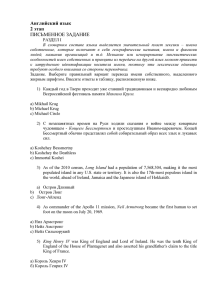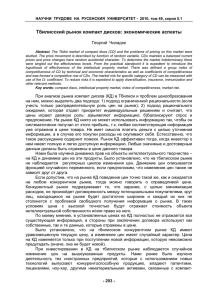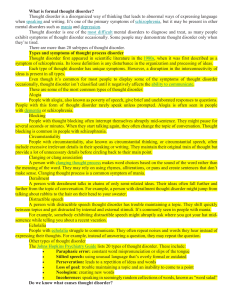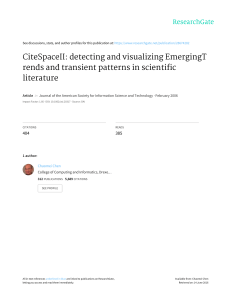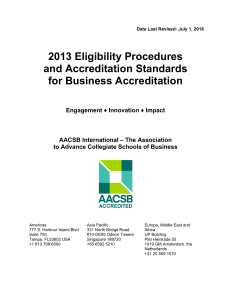ПЕРЕВОД В СФЕРЕ ИНТЕЛЛЕКТУАЛЬНОЙ СОБСТВЕННОСТИ
advertisement
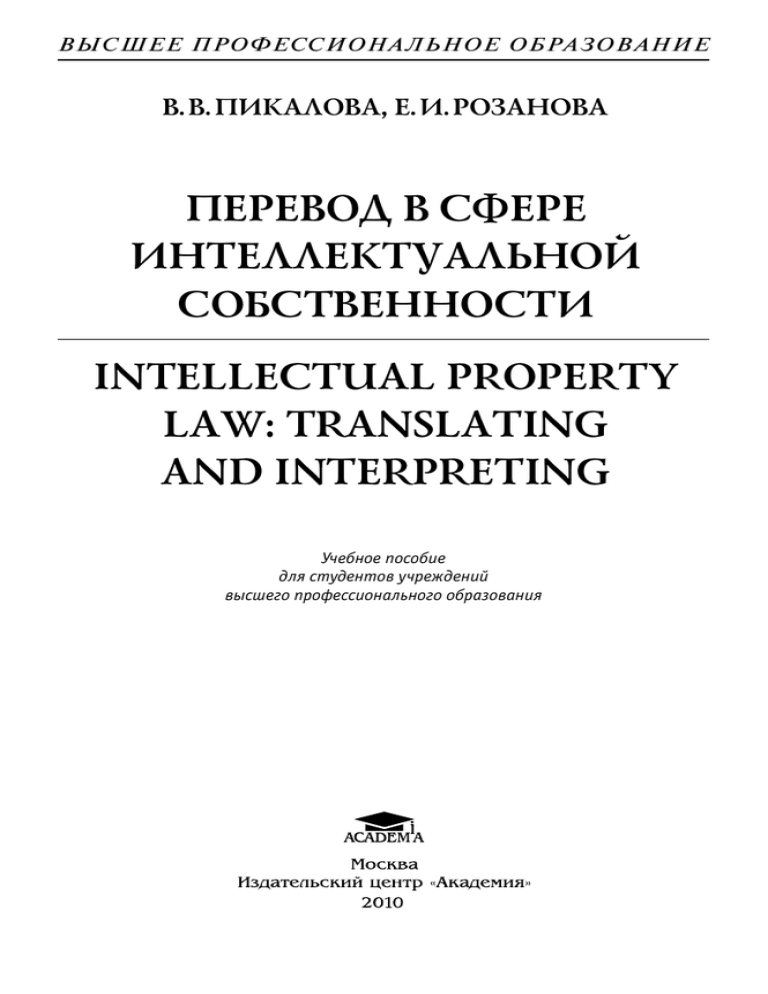
ВЫСШЕЕ ПРОФЕССИОНАЛЬНОЕ ОБРАЗОВ АНИЕ В. В. ПИКАЛОВА, Е. И. РОЗАНОВА ПЕРЕВОД В СФЕРЕ ИНТЕЛЛЕКТУАЛЬНОЙ СОБСТВЕННОСТИ INTELLECTUAL PROPERTY LAW: TRANSLATING AND INTERPRETING Учебное пособие для студентов учреждений высшего профессионального образования УДК 81:0/9(075.8) ББК 81.2-7я73 П321 А в т о р ы: В. В. Пикалова — уроки 2, 4, 6, 10 — 13, Приложения, ответы, глоссарий Е. И. Розанова — уроки 1, 3, 5, 7 — 9, 14, Приложения, ответы, глоссарий Р е ц е н з е н т ы: доктор филологических наук, профессор кафедры иностранных языков № 3 РУДН А. Л. Семенов; доктор филологических наук, доцент кафедры славянской филологии МГОУ Е. М. Маркова П321 Пикалова В. В. Перевод в сфере интеллектуальной собственности = Intellectual Property Law: Translating and Interpreting : учеб. пособие для студ. учреждений высш. проф. образования / В. В. Пикалова, Е. И. Розанова. — М. : Издательский центр «Академия», 2010. — 144 c. ISBN 978-5-7695-6849-7 Пособие состоит из 13 уроков, двух справочных приложений и глоссария; рассчитано на 40 — 46 часов аудиторной и 30 — 36 часов внеаудиторной работы студентов. При его написании использовались тексты из зарубежных учебников, материалы Интернет, англоязычные периодические издания. Для студентов учреждений высшего профессионального образования, обучающихся по программе подготовки переводчиков в области профессиональной коммуникации, на завершающем этапе изучения английского языка. УДК 81:0/9(075.8) ББК 81.2-7я73 Оригинал-макет данного издания является собственностью Издательского центра «Академия», и его воспроизведение любым способом без согласия правообладателя запрещается ISBN 978-5-7695-6849-7 © Пикалова В. В., Розанова Е. И., 2010 © Образовательно-издательский центр «Академия», 2010 © Оформление. Издательский центр «Академия», 2010 ПРЕДИСЛОВИЕ В настоящее время подготовка специалистов, способных выполнять переводы юридических материалов на профессиональном уровне, переходит в разряд чисто практической необходимости. Этот элективный курс по переводу в сфере интеллектуальной собственности предназначен для студентов вузов, обучающихся по программе подготовки переводчика в области профессиональной коммуникации, на завершающем этапе изучения английского языка. Предполагается, что к началу занятий по этому пособию студенты уже освоили курс практической грамматики английского языка и владеют навыками работы с различными словарями. Авторы не стремились проиллюстрировать с помощью предлагаемого материала курс теории перевода. Цель пособия — помочь студентам научиться решать конкретные переводческие задачи на основе сопоставительного метода, принятого в отечественной практике преподавания перевода; сформировать у них коммуникативную компетенцию и автоматические навыки устной и письменной межъязыковой трансляции юридических текстов в сфере интеллектуальной собственности. Обучение переводу направлено на формирование двух основных умений: правильно понять содержание текста на языке оригинала; полно и точно передать это содержание средствами языка перевода. Пособие состоит из 14 уроков. Каждый из них содержит: дотекстовые лексические упражнения, позволяющие провести предварительную подготовку когнитивной части перевода при изучении новых понятий, являющихся значимыми в области прав интеллектуальной собственности; аутентичные тексты для просмотрового, аналитического и изучающего чтения на английском языке; послетекстовые упражнения для активизации лексики текстов; тексты для устного и письменного перевода с английского языка на русский и с русского языка на английский; тексты для последовательного перевода. Уроки включают упражнения различной сложности, поэтому методика работы во многом будет зависеть от уровня подготовки группы, наличия учебного времени. В целом пособие рассчитано на 40 — 46 часов аудиторной и 30 — 36 часов внеаудиторной работы. Для отработки навыков устного последовательного перевода предлагается два типа упражнений. Первые предполагают участие преподавателя: он читает оригинальный текст (возможна запись на 3 электронный носитель), а студент последовательно переводит каждое предложение. Упражнения второго типа, состоящие из вопросов на русском языке и ответов на английском, предназначены для работы в парах и группах. Они дают возможность пройти интенсивный тренинг переключения с языка на язык, отразив реальную коммуникативную ситуацию; увеличить активный запас базовой лексики и овладеть навыками переводческих трансформаций. Задания по письменному переводу текстов, представляющих определенные трудности, а также упражнения на грамматические и лексические особенности, иллюстрирующие основные переводческие проблемы, предусмотрены для домашней работы с последующим обсуждением в группе. Уроки 1 — 4, 7, 8, 10 и 13 предназначены для аудиторных занятий; рассчитаны каждый на 2 часа работы. Уроки 5, 6 и 9 являются итоговыми и нацелены на повторение и проверку усвоенной лексики; рассчитаны каждый на 2 часа работы. Уроки 11 и 12 представляют информационно насыщенный тематически неделимый материал, и поэтому содержат большое количество заданий; рассчитаны каждый на 4 часа аудиторной работы. Урок 14 предназначен для проведения зачета по курсу в виде письменного перевода с английского языка на русский с использованием словарей или без них (на усмотрение преподавателя). В конце книги помещены 2 приложения справочного характера, которые помогут студентам в анализе текстов с точки зрения переводческих трудностей и выборе адекватных вариантов перевода. Также пособие снабжено глоссарием и ответами к упражнениям «закрытого» типа, что позволяет использовать его для самостоятельного изучения данной тематики. Характер текстового материала и его расположение не обязывают к строгому следованию предложенному порядку. Перевод терминов не рассматривается как универсальный и единственно возможный и допускает варьирование. При написании пособия использовались юридические тексты из зарубежных учебников, материалы, размещенные в сети Интернет, и англоязычные периодические издания. Список литературы приводится в конце книги. Авторы выражают искреннюю благодарность рецензентам — доктору филологических наук, профессору А. Л. Семенову и доктору филологических наук Е. М. Марковой за доброжелательное отношение и высокую оценку работы, за их советы и рекомендации. Также особую искреннюю благодарность авторы рады выразить кандидату филологических наук, доценту Московской государственной юридической академии А. В. Дорошенко за высокопрофессиональную помощь и рецензирование материалов рукописи. UNIT 1 Introduction VOCABULARY intellectual property интеллектуальная собственность tangible rights имущественные права to qualify for подпадать под право goodwill деловая репутация, нематериальные активы, гудвил patent law патентное право trade-mark; trademark торговая марка/товарный знак copyright law авторское право design law закон о промышленных образцах industrial property промышленная собственность passing off 1) подмена товара; 2) ведение дел под чужим именем sui generis rights права, охраняющие нетрадиционные объекты интеллектуальной собственности copyright notice предупреждение (уведомление) об авторском праве 1. Give Russian equivalents: human intellectual endeavour sheer dint to bolster unwarranted interference umbrella term overlap property paradigm legal entitlement to be precluded aesthetic designs to encompass statutory and common law provisions semi-conductor topography primarily functional designs to accord, to be accorded plant breeder’s right 5 2. Read the texts and translate them paying attention to the words and grammar constructions in bold. WHAT IS INTELLECTUAL PROPERTY (IP)? IP is frequently referred to as ‘the novel products of human intellectual endeavour’. Yet, the use of the term ‘property’ to describe intellectual products implies the existence of rights and, perhaps more importantly, remedies in respect of * the property and any unwarranted interference with in. A property paradigm, in turn, implies a system of control to be exercised by the right holder, that is, control of the subject matter* of his property right. What makes a book your book in legal terms is the fact that no one can take, use or otherwise interfere with your property without your permission. At first level, intellectual property protection operates in a similar fashion. It is concerned with identifying and policing permissible and impermissible dealing with intellectual products, usually by reference to the consent of the right holder, at least in the first instance. However, in many other respects an analogy with tangible rights — that is, property rights over physical entities — does not help us to understand what we mean by intellectual property. For example, your book will not stop being your book at midnight tonight, yet in most cases intellectual property rights eventually expire, leaving the subject matter without an owner and so free to be used or exploited by anyone. Similarly, no one can require you to lend your book to others so that they might benefit from it, whereas with certain forms of intellectual property compulsory licences can be granted to third parties to exploit the property in question. Finally, all forms of intellectual property must qualify for protection according to stringent criteria which vary depending on the kind of property right that is being sought. This is not true of the other forms of property which assume the quality of property by sheer dint of their experience. In law, intellectual property is an umbrella term for various legal entitlements which attach to certain names, written and recorded media, and inventions. The holders of these legal entitlements may exercise various exclusive rights in relation to the subject matter of the IP. The term intellectual property reflects the idea that this subject matter is the product of the mind or the intellect. The term implies that intellectual works are analogous to physical property and is consequently a matter of some controversy. WHAT IS INTELLECTUAL PROPERTY LAW? IP law comprises a wide range of forms of protection for intellectual property. It encompasses statutory and common law provisions and has * Words marked with an asterix * see Appendix 1: Lexical remarks for lexics and Grammar focus for grammar constructions. 6 aspects which are shaped by international, European and national consideration. THE STATUTORY RIGHTS There are four principal forms of intellectual property, and in the UK these are protected by statute. They are as follows: Patents — Patents Act 1977. Patent law protects inventions, which can be described as technical solutions to technical problems. An invention can be a product or a process. An invention is the paradigmatic example of ‘industrial property’. Copyright — Copyright, Design and Patents Act 1988. Copyright law is designed to protect aesthetic and artistic creations such as literary, musical, dramatic and artistic works — known as original works — together with derivative works such as films, sound recordings, cable programmes, broadcasts and the typographic arrangement of a published work (i. e. the way the material is laid out). Copyright was expanded considerably throughout the course of the 20th century to protect new and emerging forms of intellectual property such as computer software and databases. Copyright protection arises on the creation of a protectable work. There is no need to register the right. Designs — Registered Designs Act 1949 and Copyright, Design and Patent Act 1988. Design law protects the way in which a commercially produced article ‘looks’ and/or ‘functions’. Designs can either be protected by registration (aesthetic designs) or automatically on the creation of a design document or an article embodying the design (primarily functional designs). The two forms of protection are not mutually exclusive. There is much potential for overlap between copyright protection for artistic works and design protection. Trade marks — Trade Marks Act 1994. Trade marks operate to distinguish the goods and services of one enterprise from those of another. They exist as badges of origin and help the consumer to avoid confusion between goods or services of variable quality. Trade mark can assist greatly in bolstering protection for goods already protected by another form of intellectual property law. For example, patent protected drugs will invariably carry their own trade mark, e. g. Valium or Aspirin. Trade mark protection is awarded by registration. 3. Read the text and translate it orally. COMMON LAW ACTIONS Beyond these statutory rights a number of common law actions are also considered to make up the body of intellectual property law in the UK. Passing off protects the reputation or ‘goodwill’ of traders in respect of their product ‘get-up’, name or trading style. The action becomes 7 relevant when traders copy a rival’s ‘get up’ and when this leads to, or is likely to lead to, public confusion between the competing products. There is much scope for overlap between trade mark protection and passing off. Often both actions are brought in same dispute. 4. Read the text to yourself as quickly as possible. Give Russian equivalents of the words in bold. Render the main content of the text in Russian. SUI GENERIS RIGHTS In more recent years a series of new intellectual property rights have been introduced, usually because of the success of arguments that existing forms of protection are inadequate to accommodate emerging technologies, and/or because political agendas have desired a novel and unique form of protection. Some key examples include the following: Semi-conductor topography concerns the layout of computer circuit boards. The UK originally created a ‘topography right’ in 1989 to comply with the European Directive. Since then topographies have been protected as a special form of unregistered design right. The move to protect this form of intellectual property came after pressure was brought to bear by the USA which threatened to exclude foreign nationals from protection under its own law if equivalent provision did not exist in their own countries. Plant breeders’ rights: new varieties of plants and seeds can be protected by a right of protection under UK legislation which complies with a European Regulation from 1994. Database right: compilation of data can receive protection in Europe as a database in two separate ways. First, if the structure of the compilation is original, then the structure is protected by copyright. Second, the underlying material can be protected if sufficient investment has been made in its compilation. ‘Investment’ is broadly defined and includes both investment of time and money. This material is protected by a ‘database right’ which entitles the ‘maker’ of the database to prevent another from extracting the whole or a significant part of the database without permission. This is a sui generis form of protection which is not required under international obligations. It will therefore only be accorded to foreign nationals whose country accords similar degrees of protection. Copyright protection in the contents of the database is not precluded by the existence of the new right. 5. Translate into Russian using different ways to render subject/to subject. 1. Each lot is the subject of a separate contract of sale. 8 2. Personal interests can be compromised, for example, when control is relinquished to a third party and the property is subjected to some form of derogatory treatment. 3. For example, in the case of the Mickey Mouse cartoon, the image and name of Mickey Mouse would be the subject of trademark legislation, while the cartoon itself would be the subject of copyright. 4. Another point of distinction is that a copyright (and a patent) is generally subject to a statutorily-determined term, whereas a trademark registration may remain in force indefinitely if the trademark is periodically used and renewal fees continue to be duly paid to the relevant jurisdiction’s trade marks office or registry. 5. Subject to the discussion above, some general comments can be made concerning the application of the absolute grounds for refusing to register a trade mark. 6. This was however subject to the proviso that the association had to be such as to be ‘detrimental as to the character or repute of the mark’. 7. Subject to the Brussels Regulation, persons domiciled in a Member State shall, whatever their nationality, be sued in the courts of that Member State. 8. A well-known authority upon the subject of Intellectual Property Law has thus expressed himself. 6. Fill in the gaps with appropriate prepositions and translate the text from English into Russian. DIFFERENCES FROM RELATED LAWS Unlike copyright law which provides … (1) criminal penalties as well as civil damages, trademark law in the United States is entirely enforced … (2) private lawsuits. The responsibility is entirely ... (3) the mark owner to file suit in either state or federal civil court in order to restrict an infringing use. Failure* to ‘police’ a mark by stopping infringing uses can result … (4) the loss of protection. Also in contrast … (5) copyright or patent law, trademark protection has no expiration. As long as the mark is continually used, it can be protected … (6) infringement indefinitely. Because federal trademark law is derived … (7) Congress’ Commerce Clause power, and not a specific clause in the US Constitution (like copyrights and patents), there must be some degree of interstate commerce present for a trademark to receive Lanham Act protection. The US Supreme Court invalidated the first federal trademark law by finding that Congress could not stretch the Copyright Clause to cover trademarks, so Congress had to fall back … (8) only those trademarks used in interstate commerce instead. 9 7. Translate the text in written form. THE HAGUE CONFERENCE ON PRIVATE INTERNATIONAL LAW For a number of years the Hague Conference on Private International Law has been working on the text of a Convention that would harmonize jurisdiction and enforcement of judgments for commercial matters. However, the proposals have proved controversial, not least in the area of intellectual property. From ambitious beginning in 1996: ‘…to include in the Agenda of the Nineteenth Session the question of jurisdiction, and recognition and enforcement of foreign judgments in civil and commercial matters’ the Convention, as finally agreed on 30 June, 2005, concerns only agreed exclusive choice of court clauses in civil or commercial matters and the enforcement of judgments. The measures of intellectual property proved to be consistently difficult to negotiate. Questions arose as to whether intellectual property should be included at all, and if so, whether questions as to the validity of registered rights should be excluded. On intellectual property matters the Convention does not apply to: • The validity of intellectual property rights other than* copyright and related rights; • Infringement of intellectual property rights other than copyright and related rights, except where infringement proceedings are brought for breach of a contract between the parties relating to such rights, or could have been brought for breach of that contract; • The validity of entries in public registers. But Article 2.3 goes on to state that notwithstanding* what is said in Article 2 if an excluded matter arises ‘merely as a preliminary question and not as an object of the proceedings’, in particular if it arises by way of defence, then proceedings are not excluded from the Convention ‘if that matter is not an object of the proceedings’. 8. Translate from Russian into English in written form using the active vocabulary. 1. Термин «исключительные права» условен. В данном случае под ним следует понимать абсолютное право на нематериальный объект, с включением в него более широкого объема правомочий и средств защиты, чем для материальных вещей. 2. В РФ термин «интеллектуальная собственность» был узаконен Конституцией РФ 12 декабря 1993 года. Хотя статья 44 Конституции РФ, закрепляющая свободу литературного, художественного, научного, технического и других видов творчества, не раскрывает содержание данного понятия, она подчеркивает, что «интеллектуальная собственность охраняется законом». 10 3. Под интеллектуальной собственностью в российском законодательстве понимается не что иное, как совокупность исключительных прав на результаты интеллектуальной деятельности, а также на некоторые иные приравненные к ним объекты, такие как средства индивидуализации участников гражданского оборота и производимой ими продукции (работ, услуг). 4. «...В случаях и в порядке, установленных Кодексом и другими законами, признается исключительное право (интеллектуальная собственность) гражданина или юридического лица на результаты интеллектуальной деятельности и приравненные к ним средства индивидуализации юридического лица, индивидуализации продукции, выполняемых работ или услуг (фирменное наименование, товарный знак, знак обслуживания и т. п.)» 5. Круг охраняемых в РФ объектов интеллектуальной собственности за последние 10 — 15 лет пополнился полезными моделями, наименованиями мест происхождения товаров, топологиями интегральных микросхем, программами для ЭВМ, базами данных и др. 6. Охрана прав интеллектуальной собственности иностранцев определяется, наряду с национальным правом государства суда международными договорами, в которых участвует это государство. 7. Особое место среди договоров по вопросам интеллектуальной собственности занимают так называемые базовые конвенции: Парижская конвенция по охране промышленной собственности 1883 г.; Бернская конвенция об охране литературных и художественных произведений 1886 г.; Всемирная конвенция об авторском праве 1952 г.; Римская конвенция об охране интересов артистов-исполнителей, производителей фонограмм, органов радио- и телевещания 1961 г. 8. В отношении интеллектуальной собственности не действуют коллизионные нормы, за исключением договорных отношений по вопросам уступки или передачи этих прав. 9. Student A: read the text sentence by sentence. Student B: translate the text. SUMMARY OF COMMON THEMES A series of common themes and elements run through many, sometimes all, forms of intellectual property protection. Qualification for protection: novelty. All forms of intellectual property must be ‘new’ in order to receive the protection of the law. However, the degree to which a creation must be new varies with each form of the IPR. 11 Procedure for protection: registration. Many of the statutory IPRs require registration. This assists in the identification of the property to be protected and administration of the rights to be granted. Form of protection: monopoly. Monopolies are granted to IP producers to control how their property is used and exploited by others. Different forms of monopoly attach to the different IPRs. Note, however, a common feature of these monopolies is that they only give a negative right of exclusion from the marketplace. That is, there is no positive entitlement to privilege or success in the market, and the right is a public right to be exercised against those who would compete with the IP holder in a public forum. Intellectual property constrains rarely reach into the private sphere. Thus any party who has privately used an invention prior to its being the subject of a patent, or anyone who has honestly and concurrently been using a mark prior to its registration by a third party, cannot be prevented from continuing in their enjoyment of their property. Duration of protection: time limits. One feature of the need to strike a balance in the provision of intellectual property protection can be seen in the imposition of the time limits on the duration of many intellectual property rights. Often, this is connected with the strength of the monopoly which is offered. Implementation of protection: remedies. The remedies which are available for infringement of intellectual property rights are, in the main, uniform. 10. Match copyright notices with their description and translate the text from English into Russian. Patent pending ® © ™ D P T 1. Copyright protection arises automatically whenever a qualifying work is created. However, in order to gain international recognition and reciprocity of that protection under the Universal Copyright Convention (1971), this symbol should appear on the work, together with the name of the author and the date when the work was first made publicly available. 2. This term is used once a patent has been applied for but before it is granted. Inventors attach this to their inventions to put rivals on notice that an application is being considered. The novelty of an invention is tested by reference to what was publicly available prior to a patent application being filed. In this period an invention must not appear in the public domain — if it does, protection will never be granted. Once an application is filed, however, marketing of the invention can go ahead without any risk of prejudice to the patent application. 3. Intellectual property producers sometimes attach this symbol to signs, names or logos in an attempt to infer that these are trade marks. Often 12 4. 5. 6. 7. this happens when trade mark protection has been refused, or is unlikely to be granted, or the producer does not want to go to the time and expense of registering his mark. In Europe, this symbol has no legal effect whatsoever. This symbol indicates that a trade mark is registered. Only formally registered marks are entitled to appear with this symbol. It is an offence falsely to represent that a mark is a registered trade mark. This symbol appears in respect of topography rights under the EC Directive 87/54 of 16 December, 1986. T*. This notice appears on registered designs which seek recognition under the Hague Agreement Concerning the International Deposit of Designs (1960).The encircled symbol must appear together with the year of the deposit, the name of the deposit, and number of the deposit. This symbol puts others on notice that rights of producers of phonograms or performers are being claimed under the Convention for the Protection of Performers, Producers of Phonograms and Broadcasting Organisations (1961). As above, name and date must also appear.
